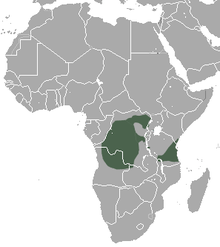Angola colobus
| Angola colobus[1] | |
|---|---|
 | |
| Scientific classification | |
| Kingdom: | Animalia |
| Phylum: | Chordata |
| Class: | Mammalia |
| Order: | Primates |
| Family: | Cercopithecidae |
| Genus: | Colobus |
| Species: | C. angolensis |
| Binomial name | |
| Colobus angolensis P. Sclater, 1860 | |
 | |
| Angola Colobus range | |
The Angola colobus, Angolan black-and-white colobus, or Angolan colobus (Colobus angolensis) is an arboreal Old World monkey belonging to the Colobus genus.
Taxonomy
There are six recognized subspecies and one undescribed subspecies from the Mahale Mountains in Tanzania:[1]
- Angola colobus, Colobus angolensis
- Sclater's Angola colobus, Colobus angolensis angolensis
- Powell-Cotton's Angola colobus, Colobus angolensis cottoni
- Adolf Friedrichs's Angola colobus, or Ruwenzori black-and-white colobus, Colobus angolensis ruwenzorii
- Cordier's Angola colobus, Colobus angolensis cordieri
- Prigogine's Angola colobus, Colobus angolensis prigoginei
- Peters's Angola colobus or Tanzanian black-and-white colobus, Colobus angolensis palliatus
Physical characteristics
Like all black-and-white colobi, the Angola colobus has black fur and a black face, surrounded by long, white locks of hair. It also has a mantle of white hair on the shoulders. The long, thin tail can be either black or white, but the tip is always white. There is a significant regional variation in the total amount of white on the body and the length of the fur. Animals that live in the mountains have longer, thicker fur than animals from the lowlands to protect them against the cold.
The Angola colobus has a head-body length of 50 to 70 cm, with the males usually being larger than females. The tail is about 75 cm long, and the body weight varies between 9 and 20 kg.
Distribution and habitat
The Angola colobus occurs in dense rainforests, both in the lowlands and coastal mountains. It lives in most of the Congo Basin, to the south and northeast of the Congo River, as far as Ruwenzori, Burundi and southwestern Uganda. The species can also be found in East Africa, especially in the montane and coastal forests of Kenya and Tanzania and in isolated mountain areas. Although the species is named after Angola, it is quite rare in that country. Of all Colobus species, the Angola colobus occurs in the southernmost latitudes. The geographical range lies south of that of the mantled guereza. It is found up to 2,415 m above sea level in Kenya.[3]
Diet
The diet of the Angola colobus consists of about two thirds of leaves and one third of fruit and seeds. The East Tanzanian population lives mainly on ripe fruit, supplemented with full-grown leaves.
References
- 1 2 Groves, C.P. (2005). Wilson, D.E.; Reeder, D.M., eds. Mammal Species of the World: A Taxonomic and Geographic Reference (3rd ed.). Baltimore: Johns Hopkins University Press. p. 168. OCLC 62265494. ISBN 0-801-88221-4.
- ↑ Kingdon, J.; Struhsaker, T.; Oates, J. F.; Hart, J. F.; Butynski, T. M.; De Jong, Y. & Groves, C. P. (2008). "Colobus angolensis". IUCN Red List of Threatened Species. Version 2008. International Union for Conservation of Nature. Retrieved 4 January 2009.
- ↑ Anderson, J.; Cowlishaw, G.; Rowcliffe, J. M. (2007). "Effects of forest fragmentation on the abundance of Colobus angolensis palliatus in Kenya's coastal forests" (PDF). International Journal of Primatology. 28 (3): 637. doi:10.1007/s10764-007-9143-7.
External links
| Wikispecies has information related to: Colobus angolensis |
| Wikimedia Commons has media related to Colobus angolensis. |
